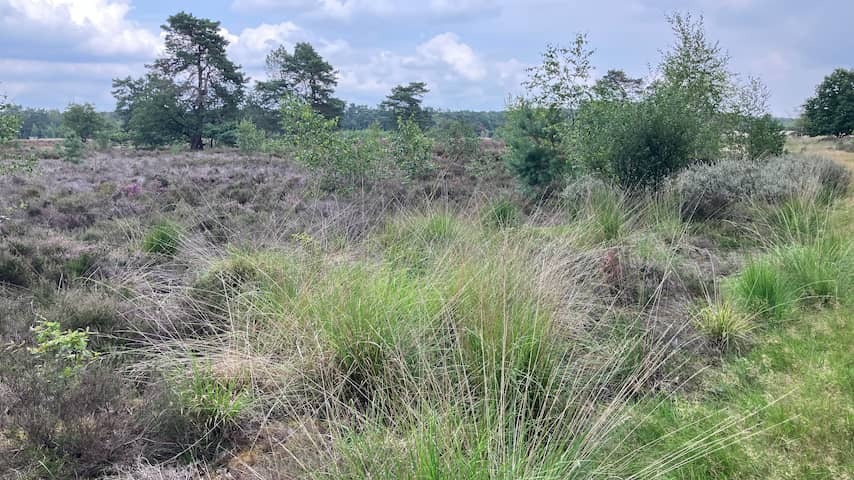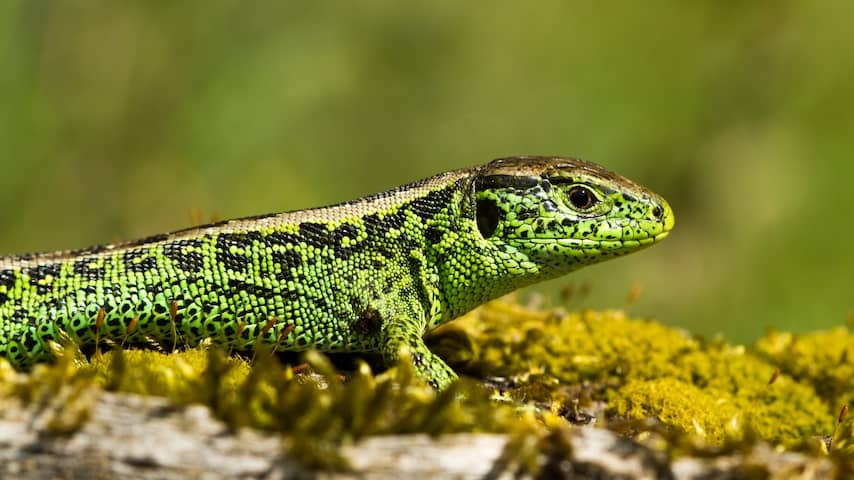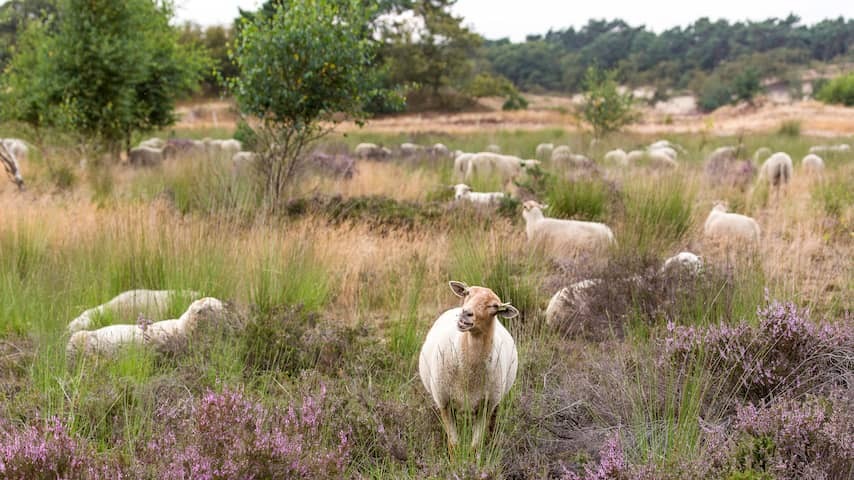
August is the month that De Heide should bloom exuberantly. But due to too much nitrogen, the heath has a hard time. Only major measures can really save the heath, experts say to NU.nl.
It should be a beautiful purple plain in this month. But in many places the heath seems to have a lush hair. It is pipe straw, a type of grass that grows much faster than heather and pushes her away.
The fact that Pijpenstrootje can grow so fast is due to the large amount of nitrogen that is present in the soil. The heath therefore has a hard time, but also other species that grow on a healthy heathland.
“Muizenor, pig’s herb, Tormentil and the Hondvizoltje. These are plant species that have disappeared from the heath on a large scale,” explains Staatsbosbeheer-Ecologist Tim Termaat. This in turn has the result that insects disappear, such as the commission butterfly, the heath blue and the blue winged grid.
The HeiVlinder is another species that is struggling because of the large amount of nitrogen. “A few decades ago it was massively found on the purple heath. Then you saw hundreds during a walk,” says Termaat. “Now you can be happy if you see one or two.”
Heide birds and lizards also have difficulty with pipe straw
Due to the disappearance of insects, certain bird species also have a hard time. The Tapuit, Duinpieper and the Korhoen for example. Field and tree larks still occur, but in less and less large numbers.
And also the sand lizard (photo below) and live -bearing lizard find it difficult to deal with the lush pipe straw. They need open spots to warm up. Due to an excess of nitrogen, those open spots grow rapidly.
Incidentally, pipe straw is definitely belonging on the heathland. But not as much as is now, says Irma de Potter, forester of Natuurmonumenten.
Ground debris scattered on the heath
Nature organizations do everything to preserve the purple heath. At Natuurmonumenten they put sheep in, among other things, that must keep the pipe straw short, as you can see in the photo below. “In the past it took 25 years for the heather to grow. Now that is possible in five years,” says De Potter.
They mow the grasses away on the Hoge Veluwe. “We do that by mowing deeply. You just grab the upper millimeters from the bottom. We leave the bottom largely intact and with that we give the heath a new chance,” says Jakob Leidekker, head of operations of the Gelderse Park.
In addition, stone flour is also sprinkled on some parts of the Hoge Veluwe. That is ground debris. Many plant species on the heaths bloom. They benefit from the minerals in the grit.
Butterflies benefit from demolishing after Second World War
The after -effects of the Second World War showed that the ground debris is good for the heath. That is the case: after the Second World War, the Allies demolished a lot from Deelen Air Base. “They only did that a little sloppy,” says Leidekker. As a result, pieces of debris remained in the ground.
When decades later many rare plants had a hard time because of an excess of nitrogen, according to Leidekker, there was “something crazy going on”. There were still many rare plants and special butterflies flew.
It turned out that exactly where the demolished parts of the airport were still in the ground, the rare plants that had a hard time in the country grew. “We investigated that and then we started scattering stone flour. First locally, but on larger pieces. There are insects that make things worse, but on average the heath benefits from it.”
Mopping with the tap open
Nevertheless, grazing with sheep and the spreading of stone flour is “symptom control,” says Leidekker. “If we want to maintain those natural systems such as the heathland sustainably, then something will have to happen.”
The Potter agrees. “The nitrogen crane must be closer. Because at the moment the mop with the tap is open.” If that does not happen, then she thinks it will cost more and more money to keep the heath.
Although it is certainly not the case that the splendor of the flowering purple heathland is nowhere to be seen anywhere. TermeMennoemt De Buurlose Heide (Gelderland), Het Dwingelderveld (Drenthe) and the Strabrechtse Heide (Brabant) as an example. “But before it was easier to find heathland that is not magnified.”
August is the month when heather is supposed to bloom profusely. But due to too much nitrogen, The Heather is struggling. Only drastic Measures can Truly Save the Heather, experts Tell Nu.nl.
It should be a beautiful purple plain this month. But in Many Places, The Heather Seems to Have A Lush Head of Hair. It is Purple Moor Grass, a Type of Grass That Grows Much Faster Than Heather and Therefore Pushes It Away.
That purple moor grass can grow so fast is due to the large amount of nitrogen present in the soil. The Heather is Having A Difficult Time As A Result, But So Are Other Species That Grow On A Healthy Heathland.
“Mouse-Ear Hawkweed, Common Pigs-Foot, Tormentil, and the Heath Dog-Violet. These are Plant Species That Have Disappeared from the Heath On A Large Scale,” Explains Staatsbosbeheer Ecologist Tim Termaat. This in Turn Causes Insects to Disappear, Such as the Comma Butterfly, The Heather Blue and the Blue-Winged Grasshopper.
The Heath Fritillary is Another Species That Is Struggling Due to the Large Amount of Nitrogen. “A few decades ago, it was massively present on the purple heath. You would see hundreds of them king a walk,” Says Termaat. “Now you can be happy if you see one or two.”
Heath Birds and Lizards also Have Difficulty with Purple Moor Grass
Due to the Disappearance of Insects, Certain Bird Species are also having a hard time. The Whinchat, The Meadow Pipit, and the Black Grouse, For Example. Field and Tree Larks Still Occur, but in Increasingly Smaller Numbers.
And the Sand Lizard (Photo Below) and Viviparous Lizard also find it diffress to cope with the lush purple moor grass. They need open spaces to warm up. Due to an excess of nitrogen, thesis open space rapidly close.
Incidentally, Purple Moor Grass Certainly Belongs on the Heath. But not as much as is currently the case, Says Irma de Potter, Forester at Natuurmonumenten.

Crushed rubble scattered on the heath
Nature Organizations Are Doing Everything They Can to Preserve The Purple Heath. At Natuurmonumenten, They Use Sheep, Among Other Things, to Keep the Purple Moor Grass Short, As You Can See In The Photo Below. “In The Past, it took 25 years for the heath to Become Overgrown. Now it can Happen in Just Five Years,” Says de Potter.
At the Hoge Veluwe, They Mow the Grasses Away. “We do this by Mowing Deeply. This allows you to take just the top millimeters of the soil with you. We leave the Soil Largely Intact, Thereby Giving the Heath a New Chance,” Says Jakob Leideker, Head of Operations at the Gelderland Park.
In Addition, Rock Flour is also scattered on some parts of the Hoge Veluwe. That is ground rubble. Many Plant Species on the Heath Flourish As A Result. They Benefit from the minerals contained in the grit.

Butterflies Benefit from Demolition After World War II
The Aftermath of World War II Showed that the crushed rubble is good for the heath. It works like this: After World War II, The Allies Demolished Much of Deelen Air Base. “They only did it a bit sloppy,” Says leader. As a result, pieces of rubble remained in the ground.
When decades later many strange plants were struggling due to an excess of nitrogen, accordance to leader “something strange was going on” neares airfield. Many Rare Plants Still Grew There and Special Butterflies Flew Around.
What turned out to be the case: Exactly Where the Demolished Parts of the Airfield Were Still In The Ground, Grew The Rare Plants That Were Struggling Elsewhere In The Country. “We invested this and then we starting scattering rock flour. First locally, but on increasingly larger are.
Komopping with the tap open
Yet Grazing With Sheep and Scattering Rock Flour is “Treating the Symptoms,” Says Leidekker. “If we want to mintain them natural systems such as the heath sustainable, something will have to happen.”
The Potter Agrees with this. “The nitrogen tap must be turned off. Because at the moment it is mopping with the tap open.” If that Doesn’t Happen, She says it will cost more and more money to preserve the heath.
Although It is Certainly Not the Case that the Splendor of the Flowering Purple Heath Can No Longer Be Seen Anywhere This Month. Termaat Mentions The Buurlose Heide (Gelderland), The Dwingelderveld (Drenthe) and The Strabrechtse Heide (Brabant) As Examples. “But Previously It was Easier to Find Heath That Has Not Been Overgrown With Grass.”